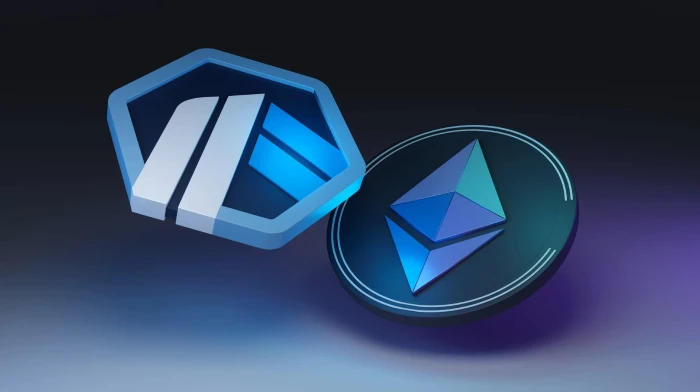
Introduction
Arbitrum is a game changer for Ethereum, offering a way to scale the network without sacrificing security. At its core, it's a Layer 2 solution that lets developers and companies create tokens with ease.
The technology behind it, called rollups, makes it possible to process transactions at a lower cost and faster than usual, all while keeping the same level of security as Ethereum's main network.
By building on Arbitrum, people can make all sorts of tokens, which opens up doors to ideas in areas like:
- Fungible tokens
- Decentralized finance
- Managing digital assets
This has the potential to make an impact across industries. The fact that this platform works seamlessly with Ethereum's infrastructure makes it an appealing option for developers who want to grow their blockchain projects without sacrificing performance or security.
Did you know? It's worth noting that fees on Arbitrum have seen some swings lately. At one point, the daily average fee per transaction shot up by 97.8% to $0.015, but after that they leveled out to around $0.007 on average.
Fee Structure Overview
Arbitrum's fee structure is an example of their goal to make things more affordable for people creating and using tokens.
What are Arbitrum Tokens?
Arbitrum is a platform that's built for speed, privacy and security. Specifically designed to help smart contracts and cryptocurrencies work better on a larger scale.
It's basically a layer on top of existing systems that makes things run more smoothly. The technology behind it, called Optimistic Rollups, is what helps make Ethereum-based apps work faster and more efficiently.
Benefits for Developers
One of the benefits for developers is that they can use Arbitrum's system to make their contracts work better. This system:
- Takes contracts written in Solidity
- Figures out how to make them run quickly and with less hassle
- Makes transactions faster and more efficient
The platform has a seamless way to link up with Ethereum thanks to something called EthBridge. This connection lets the two networks swap messages and utility tokens easily.
This setup makes things a lot simpler for developers. They can build and launch their apps using the tools and frameworks they're used to with Ethereum. It takes a lot of the hassle out of creating blockchain tokens, and developers don't have to learn a new system from scratch.
Why Create a Token on Arbitrum?
So why would someone want to create a token on Arbitrum? Well, it's an attractive option. Arbitrum's standards for its layer, combined with:
- How affordable it is to use
- How little congestion there is
- The overall timing
Make it a great alternative for launching tokens in the crypto world.
The platform makes it possible to create tokens for a wide range of uses, such as:
- Representing equity
- Creating payment systems
- Setting up exchange mechanisms
- Launching meme coin projects
- Issuing governance tokens
- Executing smart contracts
EVM Compatibility and Technical Architecture
One key aspect of the platform is its compatibility with the Ethereum Virtual Machine (EVM). The EVM is what keeps the Ethereum blockchain in sync and allows smart contracts to function.
The way it works with the EVM is by packaging large numbers of transactions into blocks, which in turn:
- Reduces the load on the main Ethereum network
- Brings down the cost of gas fees
What's more, the platform is fully compatible with the EVM, meaning that any blocks processed on the platform will be identical to those processed on the Ethereum network.
Developer-Friendly Environment
The fact that Arbitrum is equivalent to the Ethereum Virtual Machine makes it possible for developers to create contracts using languages they're already familiar with, like Solidity and Vyper, without having to make any changes.
This is a major plus for Arbitrum, setting it apart from other blockchains like Solana. The reason is that Solana and similar non-EVM blockchains require developers to learn new programming languages as well as specialized tools, which can be a significant hurdle.
Arbitrum Nitro Upgrade
Arbitrum's recent upgrade, known as Arbitrum Nitro, has been a game changer. By using WebAssembly for its low-level instructions, it's achieved something close to equivalence with the Ethereum Virtual Machine.
This means:
- Better compatibility
- Better scaling
- Lower transaction costs
Censorship Resistance and Security
One of the important aspects of Arbitrum is its ability to resist censorship. Here's how it works:
The platform relies on something called sequencers, which are responsible for accepting and processing user transactions. When you send a transaction request:
- It goes to the sequencer's address
- Gets processed right away on Arbitrum's Layer 2 protocol
- The results are published on the Ethereum mainnet shortly after (usually within minutes)
To prevent any bad actors from causing trouble, the platform has built-in safety measures. These measures help protect the network from malicious behavior, which is essential for maintaining a secure and trustworthy environment.
Important Security Feature: Sequencers can't just conjure up fake Ethereum transactions. They can only put the brakes on when real ones get posted. That's because genuine transactions need a user's seal of approval - their signature.
Delayed Inbox System
Here's the thing: if a sequencer drops the ball, users can still get their transactions on track using the Delayed Inbox system. This creates a line of people waiting to have their transactions processed. It's strictly first come, first served - nobody gets bumped to the front or cut out of line. No censorship allowed.
Market Position and Ecosystem
Arbitrum is the big kahuna in the Ethereum Layer 2 market, with a 66% share. Its total value locked is at $6.17 billion, making it the go-to L2 solution.
Arbitrum is a standout in the L2 ecosystem, boasting:
- The lowest gas costs
- The most active wallets
This makes it an attractive option for users looking for a cost-effective and vibrant environment.
Protocol Adoption
Several well-known protocols have jumped on board with Arbitrum, such as:
- Uniswap
- The Graph
- Chainlink
It's easy to see why - the platform offers a cost-effective and scalable solution.
Development Innovation
One of the reasons Arbitrum is gaining traction is its innovative approach to development. For example, its tool called Stylus opens up a world of possibilities by supporting a wide range of programming languages like:
- Rust
- C
- C++
This is all made possible by a WebAssembly-based environment, which essentially means developers have more freedom to create across platforms.
Token Creation Process
When it comes to creating tokens on Arbitrum, the process starts with deploying smart contracts. These contracts lay the groundwork for digital assets and are a fundamental part of the token creation process.
Creating custom contracts by hiring developers can be pricey, often exceeding $200. However, there are now platforms that make things easier for people without a technical background. These platforms usually charge a fee around 0.01 ETH to create a token.
This has made it possible for more people to develop blockchain tokens. The best part is that the process of generating contracts gets rid of the need for a lot of coding know-how while still keeping everything secure and working as it should.
Core Components of Arbitrum
To develop tokens effectively, it's crucial to know how Arbitrum works. Key parts of Arbitrum include its innovative design, which is vital for creating tokens that work well.
Arbitrum Rollup
The platform is made up of several parts that all fit together to make using blockchain easier. One key part is something called Arbitrum Rollup. This is the foundation of the system.
It uses a newer kind of technology to scale things up. This tech can handle transactions on a kind of side path before adding the results to the Ethereum network. By doing things this way, it:
- Cuts down on the costs of transactions
- Helps lessen the load on the Ethereum network
This rollup tech is designed to handle a lot of things at once without sacrificing security. It does this by using something called fraud proofs, which make sure that if any bad transactions sneak in, they can be challenged and fixed.
Arbitrum Chain
When it comes to the Arbitrum Chain, it works alongside Ethereum's network. It uses the same Ethereum Virtual Machine that's used for the main network, which makes it easier to create and run smart contracts.
The way this design works means it can work seamlessly with the Ethereum ecosystem, so developers can use the tools and resources they already have. This chain can process things more quickly, which leads to faster transactions and fewer of the problems that often come up due to the limitations of the Ethereum network.
Arbitrum Bridge
The Arbitrum Bridge makes it possible to move assets like ETH and ERC-20 tokens between the Ethereum network and the Arbitrum Chain.
When everything works together smoothly, it makes a big difference for users and for managing assets. This bridge:
- Makes it possible to move assets across systems securely
- Cuts down on delays
- Makes it easier for assets to flow between networks
- Helps different networks work better together
Chain Options: Nova and One
Arbitrum has two main options for its chains: Nova and One.
- Nova is an AnyTrust chain that's open to the public
- One is a rollup chain also publicly available
These distinct options give users a choice, each with its own set of characteristics.
Different projects have different ways of handling scale, which is helpful because it means they can be used in lots of different situations:
- Arbitrum One is designed for applications that need to be extremely secure and trustworthy
- Arbitrum Nova is better suited for applications where cost is a bigger concern and some level of trust can be tolerated
Benefits of Creating Tokens on Arbitrum
Creating tokens on Arbitrum has a number of benefits that make a real difference for both how the application runs and how users experience it.
Enhanced Scalability
In terms of getting things done quickly and efficiently, developing tokens on this platform has some major advantages. One of the main ways it does this is by scaling effectively.
Arbitrum's approach to layer 2 scaling means it can process many more transactions than Ethereum's main network, which makes a huge difference in terms of how much can be accomplished.
Lower Transaction Costs
Lower transaction fees are a big draw for a lot of people. The way it works is that putting your token on a platform like Arbitrum can save you a bunch of money, especially when you're making lots of transactions.
When things cost less, people are more likely to do them, which can be great for businesses that are trying to grow.
Improved Transaction Speed
The speed at which transactions happen is also really important for how people experience a service. Transactions happen a lot faster on Arbitrum than on Ethereum's mainnet, which makes it perfect for apps that need to work in real time.
This speed boost:
- Keeps users engaged
- Makes the whole platform more user-friendly
Ethereum Compatibility
One of the biggest benefits of Arbitrum is its ability to work seamlessly with Ethereum. This compatibility means developers can reuse the tools and libraries they're already familiar with, making it easy to move tokens and deploy applications.
As a result:
- Development time and costs are significantly reduced
- Developers still get to tap into the established resources they're used to
Strong Security Model
In terms of security, Arbitrum builds on the solid foundation laid by Ethereum, offering the same security model while still managing to deliver better performance.
When you bring together these elements, you create a strong foundation of protection that helps build trust with users - a crucial factor in getting a project to grow and be adopted.
Developer-Friendly Environment
In terms of development, the environment is really geared towards making things easy for developers. For those who are already familiar with Ethereum, they'll likely find that working with Arbitrum feels pretty intuitive and straightforward.
Since the development experience is similar, this means that projects can move forward quickly and with less of a learning curve, which in turn allows products to launch faster.
Step-by-Step Token Creation Guide
Creating a token on the Arbitrum network can be a bit of a complex process, but with the right approach, it doesn't have to be overwhelming.
Step 1: Define Your Token Concept
To get started, let's take a step back and think about what you're trying to achieve with your token. The first step is to define your concept. This is where you figure out what your token is actually for and what it's supposed to do.
It's like designing a product - you need to know what problem it solves and who it's for. So ask yourself some key questions:
- What's the purpose of your token?
- What makes it unique?
- What kind of functionality are you trying to build into it?
Taking the time to think through these details will make the technical part of things a lot easier down the line.
Key Considerations
To get started, it's essential to define the purpose of your token:
- What problem does it aim to solve?
- Consider the type of token you're creating (utility token, governance token, NFT, etc.)
- Think about the supply of tokens and how they'll be allocated
- Understanding your target market and the use case for your token is crucial
Who are the people that will be using your token, and what will they be using it for? Answering these questions provides clarity for the development team and helps ensure that your token ecosystem is in line with the project's goals and the expectations of your users.
Step 2: Set Up Development Environment
Before you begin creating your token, take some time to set up a proper development environment. Having a solid setup in place from the outset will make the entire process much smoother.
Establishing a strong foundation is key to successful token creation, so it's worth taking the time to get everything just right.
Required Tools
To get started, you'll need several key tools:
- Node.js and NPM - take care of packages and tools
- Hardhat or Truffle - frameworks for deploying contracts
- Ganache - for testing on an Ethereum blockchain
- MetaMask or WalletConnect - for keeping an eye on transactions
Having everything set up right makes a big difference in how smoothly your development process goes and how well you can test things.
Step 3: Develop Smart Contracts
Developing smart contracts is a crucial part of creating a token. This is where you define how your token works and set up all the rules for things like transferring, minting, and burning.
It's basically the backbone of your token, and getting it right is vital.
Essential Contract Features
A solid contract usually has several things in place:
- Mint functions - for creating tokens
- Burn functions - for reducing the number of tokens in circulation
- Transfer functions - allow tokens to be moved from one address to another
- Approval and transferFrom functions - for situations where someone else needs to spend tokens on your behalf
When these features are implemented correctly, it helps prevent problems and security issues from cropping up down the line.
Step 4: Testing and Deployment
So once the contract is all set, it's time to put it through its paces. This means conducting thorough testing - we're talking unit tests, simulation tools, the whole nine yards.
To really make sure your token is secure and working as it should, you need to test it in all kinds of situations. This helps catch any security flaws or mistakes in the logic that could compromise performance and put users at risk.
Deployment Process
Once you've thoroughly tested your token, it's time to put it on the Arbitrum network. You can use tools like Hardhat or Truffle to do this.
It doesn't matter if you're putting it on the testnet or the mainnet - either way, you need to be really careful about how you set everything up and make sure all the security measures are in place.
Step 5: Verification and Community Building
After your token is live on the network, the next step is to check that it's all legitimate on Arbitrum's block explorer.
Transparency is key to building trust and credibility, which is why it's so important to let people see the contract code and transaction details for themselves.
Building an Ecosystem
Deploying a token is just the starting point. To create a project that's going to last, you need to build an ecosystem around it. This involves several things:
- Establishing partnerships with companies that can help take your project to the next level
- Integrating with DeFi platforms for growth opportunities
- Coming up with liquidity solutions so people can buy and sell your token
- Effective marketing campaigns to get the word out
- Maintaining a strong presence on social media and other platforms
- Prioritizing education and support through documentation
Ready to Build Your Token on Arbitrum?
Get expert guidance for your Arbitrum token project. Our blockchain development team specializes in Layer 2 solutions, smart contract development, and secure token deployment. Start your journey today.
Technical Requirements and Prerequisites
To develop tokens on Arbitrum, there are some basics you need to cover.
Technical Skills
On the technical side, it's essential to have:
- A solid grasp of how blockchains work
- Experience with programming
- Knowledge of how Ethereum and its Layer 2 systems operate
- Ability to develop smart contracts
- Familiarity with standards like ERC-20 and ERC-721
Strategic Planning
On top of the technical skills, having a clear plan is vital:
- Define what makes your token useful and valuable
- Work out the economics of how it will work
- Have a governance framework in place
- Identify your target market
- Figure out how your token will be used
- Write a whitepaper that explains everything
Common Challenges and Solutions
Making tokens on Arbitrum comes with its challenges. Developers should be aware of what they might face and be ready to handle it.
Technical Setup Challenges
The technical side of things can be a headache when it comes to getting set up for Arbitrum contract deployment. For those just starting out, it's easy to feel in over your head.
The first hurdle is figuring out which tools to use and how to use them:
- Tools like Remix, Hardhat, and Truffle
- Connecting MetaMask to the Arbitrum network
This can be a daunting task if you're new to Ethereum development.
Security Concerns
When you're working with Arbitrum, there are some important concerns about security. One thing developers really need to watch out for is making sure they're using the right version of Solidity.
If they're not careful, they could end up leaving their contract open to vulnerabilities like:
- Reentrancy attacks
- Overflow issues
Security Alert: These kinds of problems can have serious consequences, so it's crucial to get it right. Testing on testnets is crucial, as are careful reviews of contracts to minimize risks.
Additional Security and Governance Challenges
Governance and Upgrade Risks
When it comes to governance and upgrades, there are some potential pitfalls to consider. The Arbitrum DAO and Security Council oversee changes to contracts.
They've built in some safeguards like waiting periods to prevent hasty decisions. Even with these precautions, there's still a chance something could slip through the cracks if updates aren't thoroughly vetted.
In emergency cases, the Emergency Security Council can step in and sidestep these buffers, which adds another layer of complexity to the whole process.
Network Dependencies
Arbitrum's ability to function relies heavily on the Ethereum network. Arbitrum's performance and security can be threatened by issues or congestion on Ethereum's mainnet, even though it was designed to scale as a Layer 2 solution.
This creates a ripple effect, putting projects at risk.
Conclusion and Best Practices
In the end, developing tokens on Arbitrum has its major perks. Developers and users benefit from faster processing times, lower transaction fees, and better scalability.
The optimistic rollup technology used by the platform manages to balance the security of Ethereum's mainnet with improved performance.
To really make a project work, you need:
- A solid idea of what you're trying to achieve
- A commitment to doing things right
- Thorough testing
- A thriving community around it
Creating a token can be a complex task, but getting some expert guidance can make all the difference. When you're trying to navigate the process of bringing a token to life, having the right know-how is crucial.
Keys to Success
The key to a successful token project on a platform like Arbitrum lies in balancing a few important factors:
- You need a solid grasp of the technical side of things
- Having a strategic plan in place and being able to execute it effectively
- Having a long-term vision that looks beyond the launch
- Building and maintaining community support
By combining technical expertise, strategic thinking, and community engagement, you can set your project up for success on Arbitrum.
Developers can make the most of Arbitrum's benefits and get ahead of potential problems to create digital assets that really work as intended.
Expert Tip: It's worth thinking about working with a team that knows what they're doing when it comes to blockchain development. They can help make sure that creating tokens is done in a way that's secure, compliant with rules, and works well.


